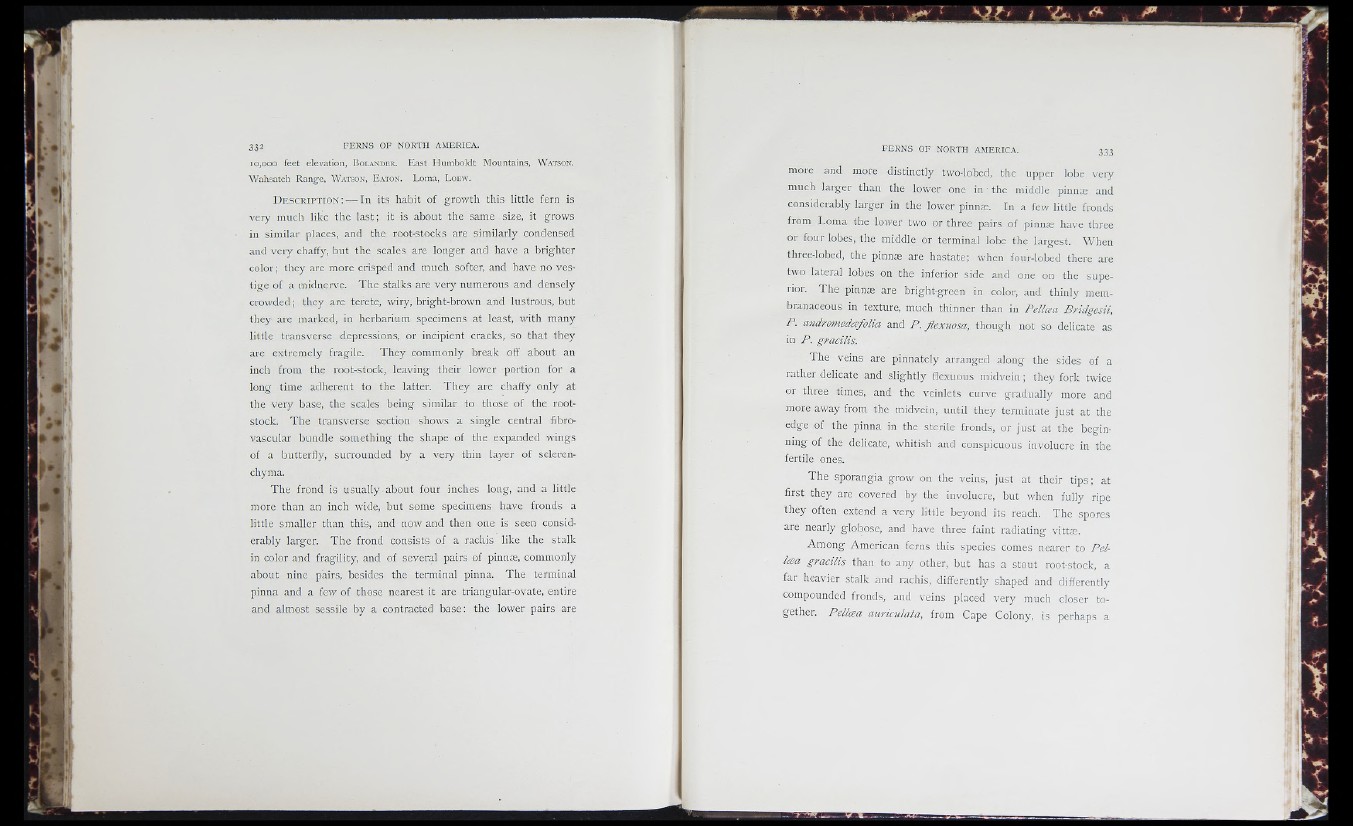
' 4 '
ml
I m
k i ]
3 3 2 F E R N S OF NORTH AM ER IC A .
10,000 feet elevation, B o la n d e r . East Humboldt Mountains, W a tso n .
Wahsatch Range, W a tso n , E aton. Loma, L o ew .
D e s c r i p t io n ; — In its habit of growth this little fern is
very much like the last; it is about the same size, it grows
in similar places, and the root-stocks are similarly condensed
and very chaffy, but the scales are longer and have a brighter
color; they are more crisped and much softer, and have no vestige
of a midnerve. The stalks are very numerous and densely
crowded; they are terete, wiry, bright-brown and lustrous, but
they are marked, in herbarium specimens at least, with many
little transverse depressions, or incipient cracks, so that they
are extremely fragile. They commonly break off about an
inch from the root-stock, leaving their lower portion for a
long time adherent to the latter. They are chaffy only at
the very base, the scales being similar to those of the root-
stock. The transverse section shows a single central fibro-
vascular bundle something the shape of the expanded wings
of a butterfly, surrounded by a very thin layer of sclerenchyma.
The frond is usually about four inches long, and a little
more than an inch wide, but some specimens have fronds a
little smaller than this, and now and then one is seen considerably
larger. The frond consists of a rachis like the stalk
in color and fragility, and of several pairs of pinnæ, commonly
about nine pairs, besides the terminal pinna. The terminal
pinna and a few of those nearest it are triangular-ovate, entire
and almost sessile by a contracted base: the lower pairs are
more and more distinctly two-lobed, the upper lobe very
much larger than the lower one in the middle pinnæ and
considerably larger in the lower pinnæ. In a few little fronds
from Loma the lower two or three pairs of pinnæ have three
or four lobes, the middle or terminal lobe the largest. When
three-lobed, the pinnæ are hastate; when four-lobcd there are
two lateral lobes on the inferior side and one on the superior.
The pinnæ are bright-green in color, and thinly membranaceous
in texture, much thinner than in Pellæa Bridgesii,
P. andromedæfolia and P. flexuosa, though not so delicate as
in P. gracilis.
The veins are pinnately arranged along the sides of a
rather delicate and slightly flexuous midvein ; they fork twice
or three times, and the veinlets curve gradually more and
more away from the midvein, until they terminate just at the
edge of the pinna in the sterile fronds, or just at the beginning
of the delicate, whitish and conspicuous involucre in the
fertile ones.
The sporangia grow on the veins, just at their tips; at
first they arc covered by the involucre, but when fully ripe
they often extend a very little beyond its reach. The spores
are nearly globose, and have three faint radiating vittæ.
Among American ferns this species comes nearer to Pellæa
gracilis than to any other, but has a stout root-stock, a
far heavier stalk and rachis, differently shaped and differently
compounded fronds, and veins placed very much closer together.
Pellæa auriculata, from Cape Colony, Is perhaps a
r i i